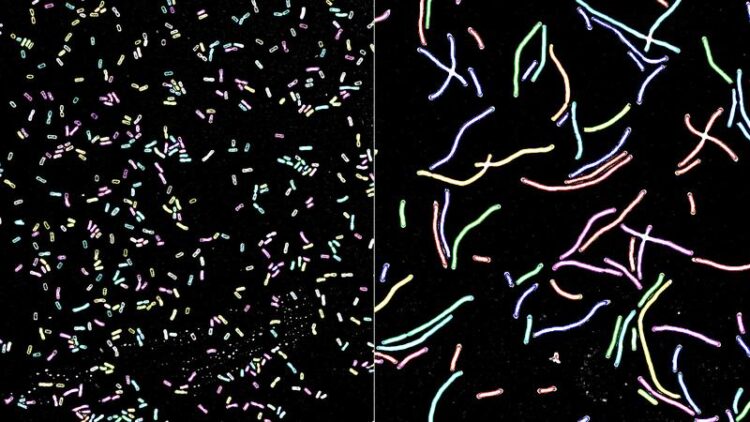Small ribonucleic acid with a big impact

Under the microscope, the Klebsiella pneumoniae bacterium typically appears in the form of short rods (left). However, if the DNA of the bacteria is damaged, the cells continue to grow in the course of the stress response and long bacteria develop (r.).
Eric Ruhland, Ruman Gerst / Graphics: Jens Meyer/University of Jena
Researchers from Jena uncover new mechanism for regulating cell division in the bacterial pathogen Klebsiella.
Klebsiella pneumoniae is one of the most common and most dangerous bacterial pathogens impacting humans, causing infections of the gastrointestinal tract, pneumonia, wound infections and even blood poisoning. With the aim of discovering therapeutically exploitable weaknesses in Klebsiella, a research team from the Balance of the Microverse Cluster of Excellence at the University of Jena, Germany has taken a close look at the molecular biology of the bacteria and was able to uncover the importance of a small, non-coding ribonucleic acid (sRNA for short) for the gene regulation of K. pneumoniae. They report their findings in the journal “Proceedings of the National Academy of Sciences”.
“Klebsiella is a relevant bacterium for research for several reasons. On the one hand, this bacterium is problematic in the clinic because Klebsiella is very adaptable, able to multiply rapidly and continuously acquire further resistances in addition to the existing natural resistances to various antibiotic agents. On the other hand, little is known about gene regulation in Klebsiella, especially in comparison to closely related species such as E. coli or Salmonella,” says Dr Kathrin Fröhlich, head of the study and junior research group leader for RNA biology of bacteria at the University of Jena. Together with a team of scientists from the Cluster of Excellence, she analysed the transcriptome of Klebsiella in search of previously unknown sRNAs and clues to their functions.
“In addition to many sRNAs that were already known from related bacteria, we also found over 50 new potential regulators,” says Eric Ruhland, first author of the study and PhD candidate at the Cluster of Excellence “Balance of the Microverse” in Jena. The researchers determined the interaction partners of all these sRNAs using a method based on high-throughput sequencing.
Autonomous cell division controll
When analysing the RNA pairings identified in this way, the sRNA DinR aroused the particular interest of the researchers. “We were finally able to find out that DinR is produced by the cell when DNA damage occurs. Under this condition, DinR inhibits the formation of FtsZ, a structural protein that is important for cell division,” says Ruhland. DinR thus controls a further, previously unknown mechanism with which the bacteria can interrupt cell division if there are defects in the genetic material. This serves to give the cell time to repair the damaged genome before it is passed on to another generation of the bacterium – from an evolutionary perspective, a mechanism that serves to produce offspring that are as healthy as possible.
“However, DNA repair is prone to errors and this stress situation leads to a higher mutation rate,” says Fröhlich. These changes to the genetic material can also lead to new antibiotic resistance or change the resistance of the bacteria. “In the future, we want to understand how exactly Klebsiella deals with DNA damage and what role sRNAs play in the comparatively high adaptability of the bacterial species, which is making Klebsiella increasingly problematic in clinical settings,” says the junior research group leader. “With this study, we are contributing to a better understanding of the fundamental molecular biological processes in Klebsiella, which may also open up ways to treat infections in a more targeted manner.”
Wissenschaftliche Ansprechpartner:
Dr Kathrin Fröhlich
Junior Research Group Leader RNA Biology of Bacteria at the University of Jena
Winzerlaer Straße 2
07745 Jena, Germany
E-mail: kathrin.froehlich@uni-jena.de
Originalpublikation:
Ruhland E, Siemers M, Gerst R, Späth F, Vogt L, Figge MT, Papenfort K, Fröhlich KS (2024): The global RNA-RNA interactome of Klebsiella pneumoniae unveils a small RNA regulator of cell division. PNAS. DOI: 10.1073/pnas.2317322121
https://www.uni-jena.de/en/all-news/small-ribonucleic-acid-with-a-big-impact
Media Contact
All latest news from the category: Life Sciences and Chemistry
Articles and reports from the Life Sciences and chemistry area deal with applied and basic research into modern biology, chemistry and human medicine.
Valuable information can be found on a range of life sciences fields including bacteriology, biochemistry, bionics, bioinformatics, biophysics, biotechnology, genetics, geobotany, human biology, marine biology, microbiology, molecular biology, cellular biology, zoology, bioinorganic chemistry, microchemistry and environmental chemistry.
Newest articles
Faster, more energy-efficient way to manufacture an industrially important chemical
Zirconium combined with silicon nitride enhances the conversion of propane — present in natural gas — needed to create in-demand plastic, polypropylene. Polypropylene is a common type of plastic found…

Energy planning in Ghana as a role model for the world
Improving the resilience of energy systems in the Global South. What criteria should we use to better plan for resilient energy systems? How do socio-economic, technical and climate change related…

Artificial blood vessels could improve heart bypass outcomes
Artificial blood vessels could improve heart bypass outcomes. 3D-printed blood vessels, which closely mimic the properties of human veins, could transform the treatment of cardiovascular diseases. Strong, flexible, gel-like tubes…




















